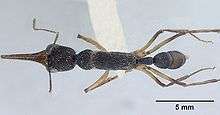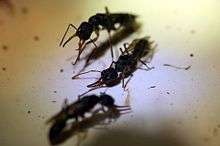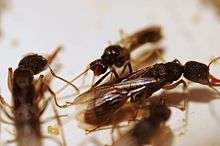Harpegnathos venator
| Harpegnathos venator | |
|---|---|
 | |
| View from above (specimen from Sabah, Malaysia) | |
 | |
| Side view (specimen from Sabah, Malaysia) | |
| Scientific classification | |
| Kingdom: | Animalia |
| Phylum: | Arthropoda |
| Class: | Insecta |
| Order: | Hymenoptera |
| Family: | Formicidae |
| Subfamily: | Ponerinae |
| Genus: | Harpegnathos |
| Species: | H. venator |
| Binomial name | |
| Harpegnathos venator (Smith, 1858) | |
| Synonyms | |
|
Drepanognathus venator, Smith, 1858[1] | |
Harpegnathos venator is a species of ant found in South and Southeast Asia. It is found in northern India and parts of Burma.
Subspecies
Description

Head view of an Harpegnathos venator worker

Queen

male and Queen
The followings is a taxonomic description of the ant based on C. T. Bingham's The Fauna of British India, Including Ceylon and Burma (Hymenoptera, Volume 2):[3]
- worker: Black ; mandibles, clypeus, antennal carinae and legs brownish yellow, antennae chestnut, apex of the abdomen rusty; head and thorax closely coarsely cribrate punctate ; abdomen finely densely reticulate punctate, opaque, with some large shallow punctures. Head, thorax and abdomen covered with rather sparse, short, erect pale hairs ; pubescence minute but fairly plentiful, to be seen only in certain lights. For the rest the characters of the genus.
- queen: Similar to the worker, but the abdomen with long oblong punctures, the ocelli in the middle of the front. Thorax and abdomen more massive and as in Harpegnathos saltator.
- male: Mandibles broad at the base, attenuate, narrow and slender towards the apex, which is directed forwards. Head rectangular, somewhat rounded, broader than long. Eyes rather smaller than in the queen. A short depression between the mesonotum and scutellum, bordered by carinae and strongly striate inside. Smooth and shining, except for the thorax, which is coarsely rugose, punctate or striate (longitudinally on the metanotum). Covered by a fine yellowish pilosity, dense on the legs, less abundant elsewhere. Pubescence very sparse. The 1st abdominal segment is pyriform and has the appearance of forming a 2nd node to the pedicel, a slight constriction between the 2nd and 3rd segments. Thorax and pedicel of a brownish black, head and basal segment of the abdomen reddish yellow. Best of the abdomen yellow with a tinge of red. Legs and antenna) very pale testaceous.
References
- ↑ Cat. vi (1858):82
- 1 2 Bolton, B. (2015). "Harpegnathos". AntCat. Retrieved 5 January 2015.
- ↑ Bingham, C.T. 1903.The Fauna of British India, Including Ceylon and Burma. Hymenoptera. Ants and cuckoo-wasps. Vol. 2 London : Taylor & Francis.
External links
 Media related to Harpegnathos venator at Wikimedia Commons
Media related to Harpegnathos venator at Wikimedia Commons
This article is issued from
Wikipedia.
The text is licensed under Creative Commons - Attribution - Sharealike.
Additional terms may apply for the media files.